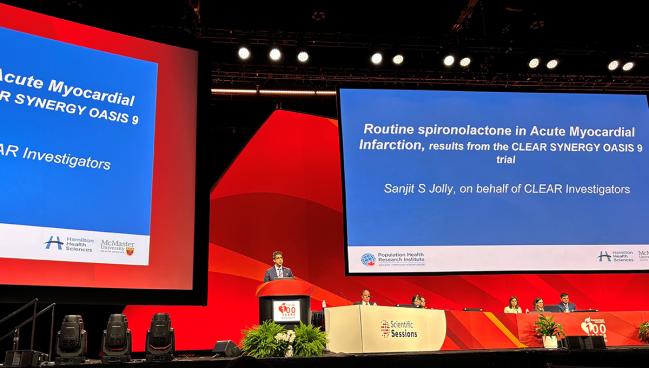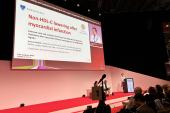Spironolactone No Help for the Heart After Acute MI: CLEAR SYNERGY
(UPDATED) Part 2 of this 7,000-patient trial suffered from discontinuations and low event rates: still, early MRAs did not impact CV events.

CHICAGO, IL—Spironolactone given to patients who have undergone PCI following an acute myocardial infarction has no impact on death from cardiovascular causes, or on a range of cardiovascular events including new or worsening heart failure, according to results from the CLEAR SYNERGY trial.
The findings deliver a second blow to this 2x2 factorial-design trial: last month, results from the colchicine arm of the study showed that giving the anti-inflammatory agent after acute MI also had no impact on hard CV events in this setting.
Sanjit Jolly, MD (Hamilton Health Sciences/Population Health Research Institute, Canada), presented the new data here at the American Heart Association (AHA) 2024 Scientific Sessions; they were published simultaneously in the New England Journal of Medicine, as were the full results from the colchicine arm of the trial.
Where colchicine failed, some had hoped a mineralocorticoid receptor antagonist (MRA) might eke out a win. Jolly, at AHA, pointed to prior studies, like EPHESUS, which showed another MRA, eplerenone, to be better than placebo in preventing all-cause deaths in patients with congestive heart failure (HF), following MI. Two additional and conflicting trials, REMINDER and ALBATROSS, further muddied the waters. Whether early initiation of MRAs, in the modern era, might be beneficial in patients more broadly was unclear.
To that end, investigators randomized 7,062 patients in 14 countries to either spironolactone or placebo immediately following PCI for STEMI or large NSTEMI. Less than 1% of patients had previous heart failure, Jolly noted in his presentation. While the number of cardiovascular deaths and new or worsening HF diagnoses over 3 years, one of the trial’s two coprimary endpoints, was numerically lower in the spironolactone arm, the difference was not statistically different (183 vs 220 events; 95% CI 0.73-1.08). Likewise, no differences were seen in first occurrence of MI, stroke, new or worsening heart failure, or death from cardiovascular causes (280 vs 294 events; HR 0.95; 95% CI 0.80-1.12).
High Rates of Drug Discontinuation
Discontinuations were common in the trial, something also seen in the colchicine randomization: fully 26% of patients in the trial went off their meds. Serious adverse events were seen in approximately 7% of patients in both the spironolactone and placebo arms of the trial, with 1.1% of MRA-treated patients developing hyperkalemia leading to drug discontinuation and 2.3% developing gynecomastia.
Given the drug discontinuations, however, investigators conducted an on-treatment analysis and showed what Jolly characterized as a “exploratory and hypothesis-generating” signal. Spironolactone-treated patients fared better than the placebo group, driven by the reduction in new or worsening heart failure.
Roxana Mehran, MD (Icahn School of Medicine at Mount Sinai, New York, NY), discussing the results at a morning press conference, stressed that both of the trial’s co-primary endpoints were “completely negative,” but agreed that the on-treatment analysis was an “interesting finding.” Still, she continued, “more granular data are needed to identify which patients might benefit the most,” particularly amid other uncertainties around the effects of drug adherence, baseline ejection fraction, extent of acute MI, and timing of revascularization.
“I believe that further investigation should clarify the role of MRAs in patients with preserved ejection fraction and/or no history of heart failure, especially after a STEMI,” Mehran said. “And of course, it's very, very important to think about that in heart failure patients as well.”
Indeed, as Jolly noted, other trials of medications proven to work in heart failure have failed to show a benefit in this early post-MI setting, including PARADISE-MI with sacubitril/valsartan and EMPACT-MI with empagliflozin. Moreover, he pointed out, the goalposts have changed since EPHESUS was published in 2003. “Over the last 20 years, the outcomes post-MI have improved remarkably so that it is actually more challenging to show a difference. We're looking at heart failure advance rates of 2 or 3%, whereas 20 years ago it was probably 10 or 15%.”
Asked if he thought it would be possible to find a drug that could move the needle, given the strides made in this patient population, Jolly didn’t rule it out.
“A more tolerable drug, perhaps finerenone [Kerendia], might have a better chance of showing an effect,” he postulated, particularly since it is associated with fewer side effects. “So there's certainly a possibility,” he told TCTMD. “And there's still an unmet need, particularly in patients that have significant LV dysfunction.”
To be part of the trial, patients had to have a left ventricular ejection fraction of no more than 45%, and Jolly clarified “LV dysfunction was allowed” among enrolled patients. “That 55-year-old who comes in with a large anterior infarct and is left with an ejection fraction of 20%, we know over the next 10, 15 years, that patient's not going to do well, he explained “Obviously heart transplant is an option in the future, but we really want to change the natural history of the disease for those type of patients.”
According to the paper, investigators did not collect information on LV dysfunction and “are unable to report results from subgroups stratified according to this characteristic.”
Speaking with TCTMD, Mehran said that the on-treatment analysis looking at a benefit on new and worsening heart failure wasn’t surprising if patients had some degree of LV dysfunction, “but you can't look at that data [and draw conclusions] in the context of an overall negative study.”
Any signal of benefit is undermined by the fact that spironolactone is a drug that people find very difficult to take, she stressed. “In this study, it doesn't look like it worked, but there was so much discontinuation of the drug and such low event rates—I don't think the trial is definitive to say that it doesn't work.”
Marc Bonaca, MD (University of Colorado Anschutz Medical Campus, Aurora), discussing the results following Jolly’s main arena presentation, also stressed the low event rates in the trial. “CLEAR SYNERGY does not support the routine use of spironolactone in patients with acute MI who are treated with primary PCI,” he concluded. “But I do think some of the observations, maybe the trend for those with anterior MI and the low incidence of heart failure, support what we already know about the known benefit [of MRAs] in those with LV dysfunction.”
It's an open question, Bonaca added, whether “novel MRAs that are better tolerated and have shown benefit across the range of EF and heart failure may be beneficial in AMI.”
Identifying Those Who Benefit
Much of the discussion after the presentation centered around the idea of identifying the patients who might benefit, with Andrew Sauer, MD (Saint Luke's Mid America Heart Institute, Kansas City, MO), asking whether investigators had looked at the results by biomarker or imaging measurements of infarct size. “As a heart failure doc, I would wonder if we're treating the disease we care about with spironolactone, which is really known for its antifibrotic properties,” he said.
Similarly, session co-moderator Rasha Al Lamee also zeroed in on the patient mix, pointing out that an all-comers population might be too diluted by those who are doing very well, after aMI, having benefited from rapid PCI and modern-day medical therapy.
In his responses, Jolly said that investigators did not collect information on infarct size, but agreed that it was an “important question.” As for the unselected patient cohort, here, too some details are likely lost in the shuffle. For the younger patient who received a single drug-eluting stent within 2 hours of an acute MI, “you’re probably wasting your time with spironolactone,” Jolly said. “It’s very different for the 80-year-old late presenter with severe LV dysfunction, who’s going to come back again and again.”
Long-time STEMI trialist, P. Gabriel Steg, MD (Hôpital Bichat, Assistance Publique-Hôpitaux de Paris, France), agreed with the other panelists on stage that CLEAR-SYNERGY provided “a clear answer with respect to routine use of spironolactone in a relatively healthy, young, STEMI patient population.”
“These patients don't derive benefit,” Steg said. “What we can see is, even in this population, there's a hint of a signal of heart failure, and we know that MRAs are remarkably effective in patients with heart failure, and we also know that they're massively underused. So I think it's a reminder that for those patients with MI who do have Killip [class] II, III, IV—for those patients who have symptoms of heart failure, then we absolutely must use MRAs.”
Jolly agreed, saying that he will use these trial results to remind his residents rounding in the CCU that routine use is not warranted, but to remain vigilant for patients with heart failure who should be started on an MRA. “Routine use is not beneficial,” he stated emphatically, but there is a “gray zone” of post-AMI patients, potentially the late presenters found to have a low-EF after revascularization, in whom the drugs may make a difference.
Shelley Wood was the Editor-in-Chief of TCTMD and the Editorial Director at the Cardiovascular Research Foundation (CRF) from October 2015…
Read Full BioSources
Jolly SS, d’Entremont M-A, Pitt B, et al. Routine spironolactone in acute myocardial infarction. N Engl J Med. 2024;Epub ahead of print.
Disclosures
- Jolly reports receiving grant/research support from Boston Scientific and consulting fees from Teleflex, Asahi, Shockwave, and Abiomed.
- Mehran reports funding from Abbott, Affluent Medical, Alleviant Medical, Amgen, AstraZeneca, BAIM, Beth Israel Deaconess Medical Center, Boston Scientific, Bristol-Myers Squibb, CardiaWave, CERC, Chiesi, Concept Medical, Daiichi Sankyo, Duke, Faraday, Idorsia, Janssen, MedAlliance, Medscape, Mediasphere, Medtelligence, Medtronic, Novartis, OrbusNeich, Pi-Cardia, Protembis, RM Global Bioaccess Fund Management, and Sanofi; consulting for Affluent Medical, Boehringer Ingelheim, Chiesi USA, Cordis, Esperion Science/Innovative Biopharma, Gaffney Events, Educational Trust, Global Clinical Trial Partners, Ltd., IQVIA, Medscape/WebMD Global, NovoNordisk, PeerView Institute for Medical Education, TERUMO Europe, and Radcliffe; and speaking fees from Elixir Medical, Stel, and ControlRad (spouse).
- CLEAR SYNERGY was funded by grants from CIHR, PHRI, and Boston Scientific.






Comments